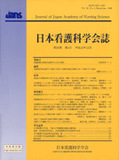Japanese
English
- 販売していません
- Abstract 文献概要
- 参考文献 Reference
要旨
本研究は,統合失調症患者のうち,病的多飲水患者と非多飲水患者,健常者の体内水分量の差異について,多周波数インピーダンス法(BIS法)を用いて探ることを目的とした.精神科病院入院中の,30~50歳代の統合失調症男性患者を対象としBIS測定を行った.比較対照群として,30~50歳代の健康な男性を対象とした.患者群の中から,独自に設定した基準に合致する者を多飲群とし,全く該当しない者を非多飲群とした.3者間で一元配置分散分析,多重比較を行った結果,体内水分割合は%ICFにおいて非多飲群が29.04±2.91と最低で,健常者群が35.15±3.77と最高であり,健常者群と多飲群,健常者群と非多飲群に有意差がみられた(p<0.01).以上から,統合失調症患者における体内水分量の特徴として,細胞内脱水傾向にあること,患者の口渇は%ICFの減少に伴う,生理的な欲求である可能性が示唆された.患者の体内水分量の分布は,非多飲群に比べて,多飲群のほうが広い範囲に分散していた.
Abstract
Purpose:The purpose of the study was to examine differences in the internal body water quantity between polydipsiacs and non-polydipsiacs using Bioelectrical Impedance Spectrum method (the BIS method, hereafter).
Method:The subjects of the study were a patient group of the schizophrenics in their 30's to 50's admitted to a mental hospital and their counter group of healthy males of the same age group. Those in the patient group were further divided into two groups, polydipsiacs and non-polydipsiacs, according to the researcher's criteria.
Results:The one-way ANOVA and multiple comparison among the three groups showed that the non-polydipsiac group had the lowest % ICF in the internal body water ratio, while the healthy group had the highest;there were significant differences between the healthy and the polydipsiac groups as well as between the healthy and non-polydipsiac groups. Thus, it was implied that the internal body water quantity of schizophrenic patients has a tendency of dehydration inside the cells and that the patients'thirst may be a physiological need accompanied with a decrease in the % ICF. The internal body water quantity was more widely distributed for the polydipsiac group than for the non-polydipsiac group.
Copyright © 2006, Japan Academy of Nursing Science. All rights reserved.


